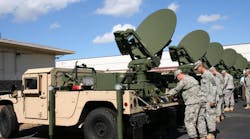As more Advanced Extremely High Frequency (AEHF) satellites are commissioned by the US military, the terminals they use for communications are being updated as well. The AEHF system provides highly secure communications capabilities for strategic command and tactical warfighters. It boasts data rates that are as much as five times faster than other systems. To support the AEHF system, the production of 39 new communications terminals was recently completed for the US Army.
To support field commanders, the Secure Mobile Anti-Jam Reliable Tactical Terminals (SMART-Ts) provide low-probability-of-detection, jam-resistant, multi-channel communications worldwide. The terminals are mounted on Humvees by the Army to pass secure data to legacy Milstar satellites. Thanks to the upgrade, those terminals are now capable of communicating with the higher-bandwidth AEHF satellites by incorporating the military’s eXtended Data Rate (XDR) waveform. This aspect enables tactical military communications—such as real-time video, battlefield mapping, and targeting data—at quadruple the capacity of the older terminals.
A typical application of SMART-T extends the range of mobile subscriber equipment to units beyond line of sight. In doing so, it allows communications support for widely dispersed forces. Each terminal is capable of standalone operation if removed from the vehicle. It also can be operated remotely. Setup/teardown can be accomplished in 20 minutes by two soldiers.
The terminal’s prime power source is a self-contained diesel generator. Every terminal includes both low-data-rate (LDR) and medium-data-rate (MDR) ports. The upgraded terminals are interoperable with current and future AEHF satellite constellations as well as Milstar, UHF Follow-On, EHF MIL-STD 1582D, and MIL-STD 188-136-compatible payloads.
The SMART-T has met three major milestones so far. In 2007, it was the first AEHF terminal to enter production. In 2010, it was the first AEHF terminal to receive National Security Agency certification for the versions used by the US and international partners’ militaries. Finally, in 2011, it was the first AEHF terminal to interoperate with the on-orbit AEHF satellite. Raytheon is currently in contract with the Army to provide effective equipment training for soldiers using the terminals.
